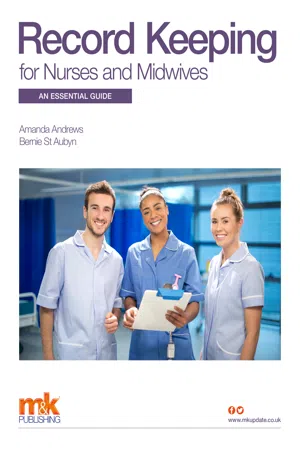
Record Keeping for Nurses and Midwives: An essential guide
- English
- ePUB (mobile friendly)
- Available on iOS & Android
Record Keeping for Nurses and Midwives: An essential guide
About This Book
For too long, record-keeping has been considered an 'add-on' to nursing care and records are often hurriedly completed at the end of a shift, almost as an afterthought. Yet, as this helpful guide demonstrates, good record-keeping is a professional obligation and a vital part of nursing care. Records provide a channel of communication between healthcare professionals and evidence of what care was given, and when and how it was given. This evidence can help protect both nurses and patients, especially if complaints are made and an issue goes to court.The authors have over ten years' experience of training nurses on the principles of record-keeping and encouraging them to reflect and think critically and professionally about their records. They begin by introducing the general principles of record-keeping, and then explain how to ensure that records are well documented and court-proof (in other words, accepted by the legal profession). They also discuss record-keeping in practice and the increasing use of electronic patient record systems. Finally, there is a quiz to test your record-keeping knowledge.
Frequently asked questions
Information
Chapter 1
Introduction to record keeping principles
Record keeping and the four stages of the nursing process
The need for good-quality records
Underlying record keeping principles
Legible and signed
Table of contents
- Cover Page
- Title Page
- Copyright
- Contents
- Preface
- Chapter 1 Introduction to record keeping principles
- Chapter 2 Court-proofing your documents
- Chapter 3 Record keeping in practice
- Chapter 4 Electronic patient record systems
- Chapter 5 Test your record keeping knowledge
- References